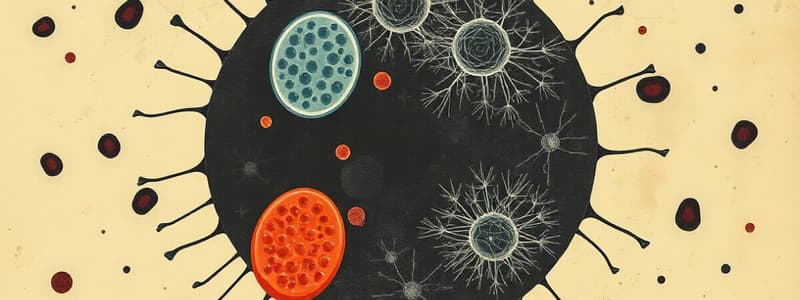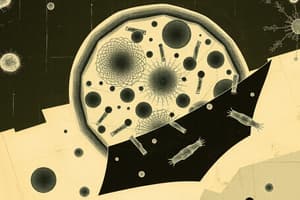Podcast
Questions and Answers
The cell membrane is composed of a ______ with embedded proteins, regulating the movement of substances into and out of the cell.
The cell membrane is composed of a ______ with embedded proteins, regulating the movement of substances into and out of the cell.
phospholipid bilayer
The ______ is a network of protein fibers that provides structural support to the cell and is involved in cell movement and intracellular transport.
The ______ is a network of protein fibers that provides structural support to the cell and is involved in cell movement and intracellular transport.
cytoskeleton
[Blank] is the process by which cells become specialized in structure and function, regulated by gene expression and environmental factors.
[Blank] is the process by which cells become specialized in structure and function, regulated by gene expression and environmental factors.
cell differentiation
The ______ processes and packages proteins and lipids, modifying, sorting, and packaging them into vesicles for transport.
The ______ processes and packages proteins and lipids, modifying, sorting, and packaging them into vesicles for transport.
While ______ does not require energy and includes diffusion and osmosis, ______ requires energy (ATP) to transport molecules against their concentration gradient.
While ______ does not require energy and includes diffusion and osmosis, ______ requires energy (ATP) to transport molecules against their concentration gradient.
During ______, cells take in substances by engulfing them in vesicles, while during ______, cells release substances by fusing vesicles with the cell membrane.
During ______, cells take in substances by engulfing them in vesicles, while during ______, cells release substances by fusing vesicles with the cell membrane.
[Blank] are responsible for protein synthesis, translating genetic information from mRNA into proteins either in the cytoplasm or attached to the endoplasmic reticulum.
[Blank] are responsible for protein synthesis, translating genetic information from mRNA into proteins either in the cytoplasm or attached to the endoplasmic reticulum.
The ______ are the powerhouses of the cell, generating energy through cellular respiration and containing their own DNA and ribosomes.
The ______ are the powerhouses of the cell, generating energy through cellular respiration and containing their own DNA and ribosomes.
Enzymes catalyze metabolic reactions, including ______ which involves the breaking down of molecules, and ______, which involves the building of molecules.
Enzymes catalyze metabolic reactions, including ______ which involves the breaking down of molecules, and ______, which involves the building of molecules.
In plant cells, ______ carry out photosynthesis, converting light energy into chemical energy, and contain chlorophyll within thylakoids arranged in grana.
In plant cells, ______ carry out photosynthesis, converting light energy into chemical energy, and contain chlorophyll within thylakoids arranged in grana.
Flashcards
What is a cell?
What is a cell?
The basic structural and functional unit of life.
Cell Theory
Cell Theory
States that all living organisms are composed of cells, the cell is the basic unit of life, and all cells arise from pre-existing cells.
Prokaryotic Cells
Prokaryotic Cells
Cells that lack a nucleus and other membrane-bound organelles.
Eukaryotic Cells
Eukaryotic Cells
Signup and view all the flashcards
Cell membrane
Cell membrane
Signup and view all the flashcards
Cytoplasm
Cytoplasm
Signup and view all the flashcards
Nucleus
Nucleus
Signup and view all the flashcards
Ribosomes
Ribosomes
Signup and view all the flashcards
Mitochondria
Mitochondria
Signup and view all the flashcards
Chloroplasts
Chloroplasts
Signup and view all the flashcards
Study Notes
- The cell is the basic structural and functional unit of life
- Cell biology is the study of cells and their functions
- All living organisms are composed of one or more cells
- New cells arise from pre-existing cells by cell division
Cell Theory
- All living organisms are composed of cells
- The cell is the basic unit of life
- All cells arise from pre-existing cells.
Types of Cells
- There are two main types of cells: prokaryotic and eukaryotic
- Prokaryotic cells lack a nucleus and other membrane-bound organelles
- Eukaryotic cells have a nucleus and other membrane-bound organelles
Prokaryotic Cells
- Bacteria and Archaea are prokaryotic cells
- They are typically smaller and simpler in structure compared to eukaryotic cells
- The genetic material (DNA) is located in the cytoplasm in a region called the nucleoid
- Prokaryotic cells have a cell wall that provides support and protection
- Many prokaryotic cells have flagella for movement
- Ribosomes are present for protein synthesis
- Some prokaryotes have plasmids, which are small, circular DNA molecules that carry extra genes
Eukaryotic Cells
- Eukaryotic cells are found in plants, animals, fungi, and protists
- Have a true nucleus, which contains the cell's DNA
- The nucleus is surrounded by a nuclear envelope
- Contain various membrane-bound organelles, such as mitochondria, endoplasmic reticulum, Golgi apparatus, lysosomes, and peroxisomes
- Plant cells also contain chloroplasts for photosynthesis
- Eukaryotic cells are generally larger and more complex compared to prokaryotic cells
Cell Structures and Functions
- Cell structures include: cell membrane, cytoplasm, nucleus, ribosomes, mitochondria, endoplasmic reticulum, Golgi apparatus, lysosomes, vacuoles, and cytoskeleton
Cell Membrane
- The cell membrane is a selectively permeable barrier that surrounds the cell, separating its internal environment from the external environment
- Composed of a phospholipid bilayer with embedded proteins
- Regulates the movement of substances into and out of the cell
- Involved in cell communication and cell adhesion
Cytoplasm
- The cytoplasm is the gel-like substance within the cell, excluding the nucleus
- Contains various organelles and cellular components
- Site of many metabolic reactions
Nucleus
- The nucleus contains the cell's genetic material, DNA, which is organized into chromosomes
- Controls cell growth, metabolism, and reproduction
- Surrounded by a double membrane called the nuclear envelope
- Contains a nucleolus, which is involved in ribosome synthesis
Ribosomes
- Ribosomes are responsible for protein synthesis
- Found in the cytoplasm or attached to the endoplasmic reticulum
- Translate genetic information from mRNA into proteins
Mitochondria
- Mitochondria are the powerhouses of the cell
- Generate energy through cellular respiration
- Have a double membrane structure with an inner membrane folded into cristae
- Contain their own DNA and ribosomes
Endoplasmic Reticulum (ER)
- The endoplasmic reticulum is a network of membranes involved in protein and lipid synthesis
- Rough ER is covered in ribosomes and involved in protein synthesis and modification
- Smooth ER lacks ribosomes and is involved in lipid synthesis, detoxification, and calcium storage
Golgi Apparatus
- The Golgi apparatus processes and packages proteins and lipids
- Modifies, sorts, and packages proteins and lipids into vesicles for transport to other parts of the cell or for secretion
Lysosomes
- Lysosomes contain enzymes that break down cellular waste and debris.
- Involved in intracellular digestion and recycling of cellular components
Vacuoles
- Vacuoles are storage organelles found in plant and animal cells
- Store water, nutrients, and waste products
- In plant cells, the central vacuole helps maintain cell turgor pressure
Chloroplasts
- Chloroplasts are found in plant cells and algae
- Carry out photosynthesis, converting light energy into chemical energy
- Contain chlorophyll, which captures light energy
- Have a double membrane structure and contain thylakoids, which are arranged in stacks called grana
Cytoskeleton
- The cytoskeleton is a network of protein fibers that provides structural support to the cell
- Involved in cell movement, cell division, and intracellular transport
- Composed of microtubules, intermediate filaments, and microfilaments (actin filaments)
Cell Functions
- Cell functions include metabolism, growth, reproduction, communication, and differentiation
Metabolism
- Metabolism is the sum of all chemical reactions that occur in a cell
- Includes catabolism (breaking down molecules) and anabolism (building molecules)
- Enzymes catalyze metabolic reactions
Growth
- Cell growth involves increasing in size and mass
- Requires the synthesis of new cellular components
Reproduction
- Cell reproduction involves cell division, which produces new cells
- Prokaryotic cells reproduce by binary fission
- Eukaryotic cells reproduce by mitosis or meiosis
Cell Communication
- Cells communicate with each other through chemical signals
- Signals can be transmitted through direct contact, local signaling, or long-distance signaling
- Cell communication is essential for coordinating cell activities and maintaining homeostasis
Cell Differentiation
- Cell differentiation is the process by which cells become specialized in structure and function
- During development, cells differentiate into various cell types, such as nerve cells, muscle cells, and blood cells
- Differentiation is regulated by gene expression and environmental factors
Cell Transport
- Cell transport involves the movement of substances across the cell membrane
- Passive transport does not require energy and includes diffusion, osmosis, and facilitated diffusion
- Active transport requires energy and includes pumps and vesicular transport
Passive Transport
- Diffusion is the movement of molecules from an area of high concentration to an area of low concentration
- Osmosis is the movement of water across a selectively permeable membrane from an area of high water concentration to an area of low water concentration
- Facilitated diffusion involves the movement of molecules across the cell membrane with the help of transport proteins
Active Transport
- Active transport requires energy, usually in the form of ATP
- Pumps transport molecules against their concentration gradient
- Vesicular transport involves the movement of large molecules or particles into or out of the cell via vesicles
- Endocytosis is the process by which cells take in substances from the external environment by engulfing them in vesicles
- Exocytosis is the process by which cells release substances to the external environment by fusing vesicles with the cell membrane
Cell Energy
- Cells require energy to perform various functions
- Energy is stored in the form of ATP (adenosine triphosphate)
- ATP is produced during cellular respiration and photosynthesis
Cellular Respiration
- Cellular respiration is the process by which cells break down glucose to produce ATP
- Occurs in the mitochondria
- Includes glycolysis, the Krebs cycle, and oxidative phosphorylation
Photosynthesis
- Photosynthesis is the process by which plants, algae, and some bacteria convert light energy into chemical energy in the form of glucose
- Occurs in the chloroplasts
- Includes the light-dependent reactions and the Calvin cycle
Cell Cycle
- The cell cycle is the series of events that take place in a cell leading to its division and duplication
- Consists of interphase (G1, S, and G2 phases) and mitotic phase (mitosis and cytokinesis)
- Interphase is the period of cell growth and DNA replication
- Mitosis is the process of nuclear division
- Cytokinesis is the division of the cytoplasm
- The cell cycle is regulated by various checkpoints to ensure proper cell division
Studying That Suits You
Use AI to generate personalized quizzes and flashcards to suit your learning preferences.




